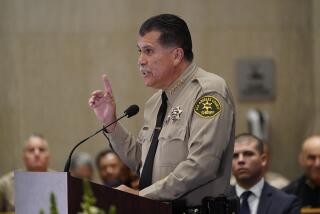Valley Gang Injunction Only Shifted Crime, ACLU Says
- Share via
A controversial court injunction may have reduced violent crime in the San Fernando Valley’s Blythe Street neighborhood but contributed to its spread into nearby communities, according to a report released Wednesday by the American Civil Liberties Union of Southern California.
Gang injunctions do not mitigate crime and therefore should be abandoned as a tactic, according to the 45-page report, “False Premise, False Promise: The Blythe Street Gang Injunction and Its Aftermath.”
But the report received a chilly reception from law enforcement authorities, including Assistant City Atty. Martin Vranicar Jr., the city’s top gang prosecutor, who noted that the ACLU unsuccessfully challenged the Blythe Street injunction in court. He questioned the organization’s motives in preparing the report and said he believes it is part of a campaign to deter his office from proceeding with a court injunction against the notorious 18th Street gang.
“I disagree with the report’s conclusion,” Vranicar said. “I continue to think the injunction is a valuable law enforcement tool that targets gang nuisance activity.” Since their inception a decade ago--when Los Angeles City Atty. James K. Hahn obtained a broad court order against a Westside gang--court injunctions have been credited with helping restore a sense of security to gang-plagued neighborhoods in the Valley, Pasadena, Norwalk and Burbank.
The injunctions work by criminalizing ordinarily legal behavior such as possessing beepers or standing on rooftops--acts that law enforcement officers contend are often precursors to crime. Gang members could use pagers, for example, to alert their colleagues that police are in the area, or stand on rooftops to act as lookouts.
Prompted by the slaying of a Van Nuys apartment owner, a Superior Court judge issued an injunction in April 1993 against members of the Blythe Street gang in what was one of the Valley’s toughest neighborhoods. The injunction triggered a debate that pitted police and prosecutors against civil libertarians, public defenders and legal scholars on the ethics of attempting to curb crimes before they are committed.
The debate continues to rage. The release of the report Wednesday came just months after a state Supreme Court decision broadly upheld civil injunctions as a tool that cities may use to combat gang activity.
According to Los Angeles Police Lt. Fred Tuller, who heads the Valley’s gang enforcement unit, the method has worked in the Valley, where the Blythe Street gang’s activities have decreased in the last four years, he said.
“I wouldn’t put the Blythe Street gang in the the top five or even the top 10 gangs that we have problems with in the Valley, where three years ago I probably would have,” he said.
Tuller added that so far this year, 17 crimes have been attributed to members of the Blythe Street gang, a relatively low figure given that some gangs average nearly that number of crimes in a month.
The ACLU report, however, contends that the widely publicized Blythe Street injunction failed to produce an immediate reduction in violent crime and drug trafficking or an immediate increase in community safety.
“Anyone who said gang injunctions were the answer to gang violence should be charged with practicing quack medicine,” spokesman Allan Parachini said Wednesday during a press conference at ACLU headquarters in downtown Los Angeles.
The report analyzed LAPD crime data between 1992 and 1995 for an area covering 19 police reporting districts. The statistics included monthly totals of homicides, rapes, attempted rapes, robberies, aggravated assaults, total calls for police service and numbers of felony drug arrests.
The report found that a slight increase in violent crime accompanied the injunction, even in the reporting district most affected by the ruling. There were 155 violent crimes recorded for that district in 1992, compared to 160 in 1993, the year the injunction was issued, the report said.
In the following years, however, the number of violent crimes for the district appeared to decrease, totaling 125 in 1994, 132 in 1995 and 117 in 1996, the report said.
Meanwhile, violence and drug trafficking began increasing in the so-called Roscoe Boulevard strip, a swath near Blythe Street that includes four LAPD reporting districts. Violent crimes in those districts rose 86% after the injunction was issued, according to the ACLU report, which does not specify the period in which the increase allegedly occurred.
That was the most dramatic change, according to the report. In the entire 19-reporting-district area, violent crimes increased 27.1% between April 1993 and August 1994, the report said.
By way of comparison, the increase in violent crime in all of Los Angeles was 16.5% between February 1993 and August 1994, according to the report.
ACLU Executive Director Ramona Ripston blames the Blythe Street injunction for increasing gang-related crime on nearby Orion Avenue, whose problems were detailed this week in a four-part Times series.
“We believe these conditions were influenced greatly and exacerbated by patterns of crime and drug trafficking that evolved after the Blythe Street injunction,” Ripston wrote Wednesday in a letter to Hahn and Dist. Atty. Gil Garcetti, asking them to meet to discuss different crime-fighting tactics.
But Vranicar said that the city attorney’s office has no plans to abandon the use of civil injunctions and that it will proceed with one being sought against the 18th Street gang.
“We’re well within the law,” he said, citing the recent state Supreme Court ruling.
A spokeswoman for Garcetti declined to discuss the report because it was based on an injunction sought by the city attorney’s office.
More to Read
Sign up for Essential California
The most important California stories and recommendations in your inbox every morning.
You may occasionally receive promotional content from the Los Angeles Times.










